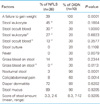Abstract
Among infants and toddlers with chronic frequent loose stool, normal frequent and loose stool (NFLS) is more common than diarrheal illness with dehydration and nutritional deficiency (DIDN). To identify more objective factors for differentiating between NFLS and DIDN is important. The frequency, mucus content, and microbiological findings of stools, as well as diaper dermatitis are not important factors to significantly differentiate the groups. Instead, a failure to gain weight, fever, colic/abdominal pain, gross blood in stool (except allergic proctocolitis), nocturnal stool, and the score of the stool quantity are important factors to significantly differentiate the groups. A failure to gain weight is also observed even in NFLS, which may come from iatrogenic diet manipulation with nutritionally deficient food. The most objective differential factors are nocturnal stool and the score of stool amount (≥7 points/day). The use of these objective factors could lessen parental anxiety and distress, iatrogenic undernutrition of patients, and socioeconomic loss due to improper medical investigations or inappropriate management of NFLS.
Figures and Tables
Figure 1
The stool amount scoring system using the mother's hand (From Hwang JB, et al. Korean J Pediatr 2010;53: 1006-1011) [5].

Figure 2
The scores of stool amount for normal controls, patients with normal frequent loose stool (NFLS), and patients with diarrheal illness with dehydration and nutritional deficiency (DIDN) (From Hwang JB, et al. Korean J Pediatr 2010;53:1006-1011) [5].

Figure 3
A diagnostic guideline for the clinical differentiation of normal frequent loose stool (NFLS) and diarrheal illness with dehydration and nutritional deficiency (DIDN). OB, occult blood; WBC, white blood cell. a)Except allergic proctocolitis (From Hwang JB, et al. Korean J Pediatr 2010; 53:1006-1011) [5].

Table 1
The associated causes of normal frequent loose stool and diarrheal illness in infants and toddlers with chronic diarrhea

From Hwang JB, et al. Korean J Pediatr 2010;53:1006-1011 [5].
Table 2
Factors for differentiation between NFLS and DIDN among infants with chronic frequent loose stool

From Hwang JB, et al. Korean J Pediatr 2010;53:1006-1011 [5].
NFLS, normal frequent loose stool; DIDN, diarrheal illness with dehydration and nutritional deficiency.
a)In 20 NFLS patients; b)Except allergic proctocolitis; c)In 15 NFLS patients; d)In 16 NFLS patients; e)In 31 NFLS patients.
References
2. Baldassano RN, Liacouras CA. Chronic diarrhea: a practical approach for the pediatrician. Pediatr Clin North Am. 1991. 38:667–686.

3. Rhoads JM, Powell DW. Walker WA, Durie PR, Hamilton JR, Walker-Smith JA, Watkins JB, editors. Diarrhea. Pediatric gastrointestinal disease: pathophysiology, diagnosis, management. 1996. 2nd ed. St. Louis: Mosby;62–78.
4. Scaillon M, Cadranel S. Hyman PE, Di Lorenzo C, editors. Transit tests. Pediatric gastrointestinal motility disorders. 1994. New York: Academy Professional Information Services;265–276.
5. Hwang JB, Kang KJ, Lee JJ, Kim AS. What is the objective differential factor of diarrhea in infancy?: Normal state versus diarrheal illness in infants with chronic frequent and loose stool. Korean J Pediatr. 2010. 53:1006–1011.

6. Maloney J, Nowak-Wegrzyn A. Educational clinical case series for pediatric allergy and immunology: allergic proctocolitis, food protein-induced enterocolitis syndrome and allergic eosinophilic gastroenteritis with protein-losing gastroenteropathy as manifestations of non-IgE-mediated cow's milk allergy. Pediatr Allergy Immunol. 2007. 18:360–367.

7. Rasquin-Weber A, Hyman PE, Cucchiara S, Fleisher DR, Hyams JS, Milla PJ, Staiano A. Childhood functional gastrointestinal disorders. Gut. 1999. 45:Suppl 2. II60–II68.

8. Liu LJ, Yang YJ, Kuo PH, Wang SM, Liu CC. Diagnostic value of bacterial stool cultures and viral antigen tests based on clinical manifestations of acute gastroenteritis in pediatric patients. Eur J Clin Microbiol Infect Dis. 2005. 24:559–561.

9. Heyman MB. Committee on Nutrition. Lactose intolerance in infants, children, and adolescents. Pediatrics. 2006. 118:1279–1286.

10. Hwang JB, Park MH, Kang YN, Kim SP, Suh SI, Kam S. Advanced criteria for clinicopathological diagnosis of food protein-induced proctocolitis. J Korean Med Sci. 2007. 22:213–217.

11. Kleinman RE. Chronic nonspecific diarrhea of childhood. Nestle Nutr Workshop Ser Pediatr Program. 2005. 56:73–79.





 PDF
PDF ePub
ePub Citation
Citation Print
Print


 XML Download
XML Download